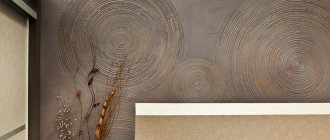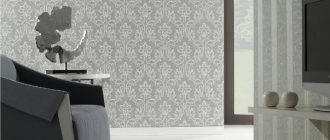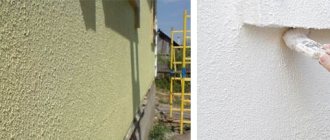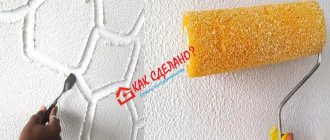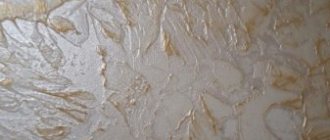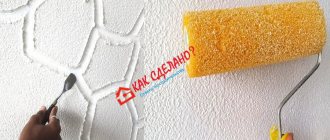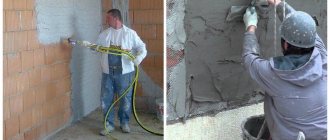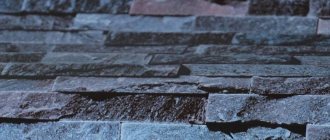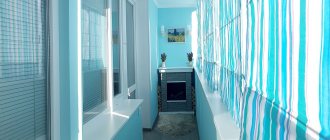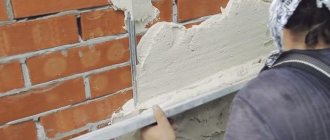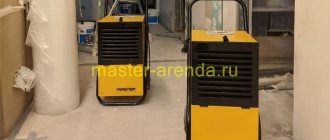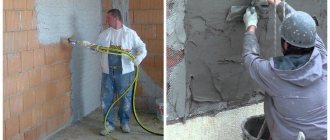The wide supply of finishing materials on the market makes us think seriously about new ways to bring your interior to life. The usual wallpaper may have become boring and no longer attracts the eye, but textured plaster for walls compares favorably with other design options with a completely new decorative level. Photos using it always look fresh and impressive, but in reality the material looks even more beautiful. Our focus today is on the best examples of using textured plaster in a wide variety of interiors. We also advise you to get acquainted with another original way of finishing walls using 3D panels, which you can learn about from the article: “3D panels for walls: the most interesting and new ideas.”
- Pros and cons of use;
- Existing species;
- Useful tips for quality application;
- 4 popular relief textures;
- A selection of photos in the interior;
- Conclusion.
Features of textured plaster
The composition of textured plaster, along with the binder, also includes other components that make its consistency softer - pieces of granite or other minerals.
Using this fine-grained mixture, it is easy to create a colorful texture on the smooth surface of the ceiling and walls. If necessary, it can be used as putty.
Plasters of this type are used for decoration. A thin layer of the composition is applied to the surface of the walls and the desired pattern or relief pattern is created on it.
Their main properties:
- plastic;
- viscosity;
- strength;
- no shrinkage after applying the layer and drying it;
- immunity to high temperatures;
- ease of application on any surface, even with imperfections.
You can make textured plaster yourself. To do this, add stone chips or wood fibers to the usual composition and tint the resulting mass.
This finishing material has a number of advantages over others:
- Textured plasters can be considered a universal way to decorate walls. The original coating can be selected for any interior style.
- Patterns and designs to create texture are done quickly and effortlessly. It is enough to move the roller one or several times.
- The composition includes components that are resistant to ultraviolet rays. The initial color saturation does not change over time.
- You can add different paints to ready-made mixtures and change their shades and tone.
- Characteristic enhancement of the thermal insulation properties of the base.
- Environmentally friendly composition. It does not release harmful substances into the surrounding space. Suitable not only for decorating the exteriors of buildings, but also interiors.
- To increase the aesthetic expressiveness of textured plaster, mother-of-pearl is added to it.
Textured or relief plaster does not smell. It also does not absorb foreign odors. When working with this material, you should strictly follow the rules for applying plasters of any kind to walls. Otherwise, it may begin to gradually collapse. Or vice versa, it will be very difficult to remove it, if necessary.
Helpful tips for quality application
It would seem that what could be simpler than applying plaster to the wall? Apparent simplicity, however, gives rise to dangerous self-confidence.
And it’s good if you have already performed this procedure more than once: in this case, the risk of making a mistake is reduced to a minimum. But what if you pick up a roller and solution for the first time? We give you some useful tips that will help you get out of this “test” with honor.
- treating the wall with a deep penetration primer is a mandatory step, this way you can achieve excellent adhesion of the textured plaster to the base, as well as protect it from premature wear and mold;
- when applying plaster to the surface, take into account the following consumption formula: for 1 square meter at least 1 kilogram of
material, the final consumption depends on the number of layers applied (a plaster consumption calculator will help you); - You can determine the required amount of paint in the solution by applying a test stroke: apply a little material to the wall and spread it with a spatula at an angle of 30% - you will immediately see whether you need to strengthen the tone or weaken it;
- to create a relief part, you can use any available means: even an old broom or toothbrush, it all depends on how well this tool helps express your aesthetic preferences;
- For beginners, a textured roller
- applying plaster is a pleasure, and the best thing is that you have impeccable control over the result.
Advantages of textured material
Textured mixtures are used for plastering any premises. They are often used to focus attention on certain architectural elements - columns, niches, false fireplaces, etc.
Main advantages:
- Moisture resistance - the compositions can be used even for finishing bathrooms and other rooms with high humidity levels.
- Increased strength – ensures the durability of the decorative coating and its resistance to mechanical stress.
- Plasticity of the finished plaster layer - the material is able to slightly stretch during operation without the formation of cracks, which makes it resistant to shrinkage deformations.
- Practicality - the finished coating does not require special care; if necessary, it can even be washed with water.
Everything can be learned by comparison: ordinary wallpaper provided the owners with a whole set of undeniable advantages, the main ones of which, perhaps, are the ease of application and versatility of use.
What about the obvious advantages of textured plaster?
- resistance to any mechanical stress;
- excellent vapor permeability;
- maintaining performance at any temperature;
- high level of fire resistance;
- not afraid of ultraviolet rays;
- variety of surface relief;
- wide selection of color options;
- no toxic substances in the composition;
- good heat and sound insulation;
- basic installation and dismantling.
As you can see, textured plaster has more than enough advantages in terms of expressive wall design - in the photo you can only see how perfectly this or that texture fits into the interior. If you go from the other side and try to “dig out” the negative, then the first thing that comes to mind is the relatively short service life.
Regarding other, more sustainable finishing materials. Otherwise, we have before us a case where even with the greatest desire to come up with a minus out of the blue, nothing happens.
Repair of texture defects
The difficulty of repair is one of the disadvantages of textured plaster coating. If you can still manage to recreate the decorative texture, making it less noticeable, then it is impossible to choose the exact color to match the previous color. In this case, it is recommended to repaint the entire wall.
Use a rubber hammer (or a plastic handle of a spatula or chisel) to tap the wall, identifying the peeling areas. The loose material is completely removed. The exposed base is cleaned, repaired, primed, and dried. For the “patch” they take the same
To repair a defect, you need to tap the wall to identify areas with peeling coatings. Carefully remove any loose areas. If necessary, repair the base. Prime and dry. Before applying the patch, moisten the edges of the old coating with water to ensure good adhesion.
The plaster composition must be taken with the same base as the old one.
It is better to make patches in a rectangular shape. To restore the drawing, you should practice on a small area.
Types of decorative plaster
In total, the finishing materials market includes over a dozen types of decorative plaster. Each option differs in composition, color content, viscosity, ductility, elasticity during application, texture, processing time, and storage. Some mixtures are perfect for finishing the facades of houses, others - for finishing interior spaces.
Silk
Plaster to which mother-of-pearl is added looks like silk-screen printing on the wall. Texture here is achieved by adding small grains of stone chips or cellulose fibers. Silk plaster has earned high marks for decorativeness due to the delicate tints of the finished coating. Glare appears depending on the viewing angle where natural or artificial light falls.
Silk plaster is ideal for the living room, bedroom, library, study, any room where there is a lot of upholstered furniture.
Bark beetle
Some interior styles harmoniously accept surfaces with an imitation of artificial aging or a protective layer spoiled by a bark beetle. For these purposes, it is appropriate to use decorative plaster in the interior with its interesting name - bark beetle.
Such finishes give the style concept greater authenticity, originality and antiquity. The basic basis of this technology is a granular mixture.
Mosaic
The appearance of single-color walls with small specks is mosaic decorative plaster. There are mixtures with different particle sizes and different colors. It is used to decorate walls both outside buildings, houses, and indoors. The surfaces are smooth and easy to clean. They are resistant to chips, scratches, and impacts from heavy objects.
This plaster fits perfectly on almost any surface - concrete, brick, standard plaster, plasterboard panel material. Another plus is good ventilation.
Art concrete
Art concrete is a modern finishing material for walls, ceilings and floors. The mixture contains dry cement and gypsum powder. Various additives, fillers, dyes, and varnishes are also added to them. Soft plasters allow you to create original imitations of a concrete surface.
They are decorated with rivets, pipes (especially in the loft style), images of slabs, stacked blocks (ideal for high-tech or minimalism styles).
Structural
Textured (or structural) plaster is called when stone chips are present in the working mass. The fraction sizes are heterogeneous. Due to this, when applied, the composition will create a volumetric texture of ground and smeared stone granules.
This is a fairly porous surface, so special care is required. It is enough to go over the walls with a damp brush, sponge, or even better, a washing vacuum cleaner.
Venetian
Venetian decorative plaster in the interior can visually expand the room. Due to the smooth surface with a slight waxy reflection and light shades. This type of plaster can easily imitate marble, malachite, onyx, carnelian and any other type of stone. Apply plaster to the previously prepared wall.
This could be a concrete slab, wood panel, drywall or regular plaster over brickwork. The number of layers is from 8 to 10, not counting the protective layer of waxing.
Sgraffito
The srgaffito plastering technology is created using 2 layers or more. Next, the top layers are cut through using special stencils or manually, obtaining beautiful even patterns, ornaments, symbols or contours. The whole effect is achieved thanks to the contrast of the colors of each layer (red flowers on a black background, blue floral pattern on a beige background).
Thanks to this method, real panels or backgrounds are obtained for the entire interior. The surface is textured, the contours of the pattern are perfectly smooth.
Craquelure
Using craquelure plastering, you can achieve an imitation of cracked desert soil, old paint or cracked plaster walls. This technique is ideal for country, loft, vintage, retro, modern, eclectic styles. An important detail of the arrangement is a successful combination of shades of the field and cracks.
For example, cracks may be dark and flat areas may be light. Here, too, there is a game of contrast. Moreover, cracks may not be throughout the entire area of the wall, but only in some part of it.
Latex plastic
A multifunctional and multi-component version of decorative plaster allows you to create different finishing designs - from polished marble imitation to exquisite Venetian plaster. The surface, after drying, becomes hard, durable and resistant to the effects of steam, water and moisture on its surface.
The decorative effect is achieved through a special additive – wax. It can be used both with the addition of a granular composition and with the use of drawing stencils.
Sea breeze
Sea Breeze plaster allows you to create the effects of a light breeze. This design fits well into almost any interior, except for the styles: Provence, country, chalet and other rustic options. The materials of the composition have high adhesion to such surfaces as: concrete, brick wall, sheets of plasterboard, ordinary plaster.
Mother-of-pearl and sand additives can be used to achieve the effect of smoke, breeze, waves or sea foam.
Marseille wax
Marseille wax is a textured type of decorative plaster. The finishing coating is smooth, despite its texture - the recesses and protrusions are carefully sanded. By adding shading, they create contrast - the recesses can be light, and the highest points dark, and vice versa.
They are most often tinted with pleasant, delicate shades:
- beige;
- dairy;
- light brown;
- pink;
- olive;
- plum with silver;
- coral;
- lavender.
The silver plating inside the recesses looks very nice, while the protrusions, edges, bulges and flat top areas are sand-colored. Marseille coverings are used both as an independent element of room decoration and as a background for furniture and other interior details.
Structural paint and flocking
To give the surface a finished look, it is coated with paint. A coating called flock (from the German flock - flakes) has become widespread; finishers also call this composition “chips” for its external similarity. Initially, an acrylic base is applied, which is characterized by slow drying, then a layer of decorative flock is applied to the wet surface and the final coating is carried out with a satin finishing varnish for painting with the functionality of a protective layer. This decorative coating can create the effect of leather, suede, nubuck.
Where is it used?
The wide range of applications of decorative textured plaster is due to the fact that it has excellent adhesion to a wide variety of surfaces.
It turns out that with the help of decorative plaster they not only complement the interiors of houses and apartments, it is also used as a full-fledged finishing material for facades and a wide variety of external walls of buildings.
In interior design, textured plaster can be used to complement the walls and ceilings of a bedroom, living room, hall, hallway, kitchen and even bathroom (if we are talking about waterproof compounds).
Many experts prefer textured plaster as a finishing material in the hallway and hallway, since these are precisely the rooms where the walls often get dirty and worn out.
On a textured surface, any imperfections will be completely invisible thanks to such an unusual coating.
Since textured plaster is very simple and unpretentious to maintain, and many of its types are not afraid of moisture, it can easily be used to cover surfaces in the bathroom and kitchen.
Basically, the scope of application of plaster in the interior of a house is limited only by imagination, so do not be afraid to experiment and bring to life the most unusual and daring ideas.
Main varieties
There are 4 main types:
Acrylic. The key component is acrylic resin. To prepare for use, simply stir the contents of the container. There are practically no differences in quality between different manufacturers. The only difference is the price.
Silicone. The main component is synthetic polymer resins. It has a long service life and high resistance to temperature changes, so it is often used for exterior decoration.
Mineral. It is made on the basis of lime hydrate. Supplied dry. Before use, the material must be diluted with water and mixed thoroughly.
Silicate. The dominant binding component is liquid glass. This material has proven itself well due to the possibility of application to almost any surface. Due to these factors, it has a fairly high cost.
Color range of textured plasters
To create plaster mixtures, natural and natural paints are most often used. It is best to imitate wood using yellow or ocher shades, such as straw, golden oak, or pear. But brown colors are also suitable - nut, light brown with a hint of ocher, coffee, cream.
- White textured plaster is most often used to decorate public buildings and offices. Its neutral shades allow you to add solemnity to any room with a large area.
- This finish is also suitable for small rooms and bedrooms. Makes them lighter, creates the illusion of exceptional purity and freshness. White walls fit perfectly into many interiors and suit any color palette. They prevail in Scandinavian style and in most modern ones.
- Gray plaster with a concrete or metal effect is chosen by lovers of high-tech, industrial, techno, minimalism or loft styles.
- Mother-of-pearl options with a beautiful patterned texture will delight owners of interiors in oriental styles - Arabic, Indian, Moroccan and Asian. The walls look especially original in combination with mirrors and decor with mother-of-pearl inclusions and silver metal.
Combination of decorative plaster with finishing
If you need to determine what types of finishes decorative plaster can be combined with in the bedroom, then you need to pay attention to the texture, color and pattern of the surface. Finishing refers to different coverings of walls, their projections, columns, niches, as well as details of the decoration of the ceiling, window or interior arched openings.
If the room is being furnished in a loft style, then a structural mixture or art-concrete plaster will work well with brick or stone masonry.
For living rooms in a classic, English or Italian style, a combination of smooth surfaces of ordinary plaster, painted in the same tone, with marble decorative plaster would be ideal.
Any authentic or ethnic style will look harmonious if you combine decorative bark beetle plaster with wooden surfaces - ceiling beams, curtain rods, shelves, furniture.
Venetian plaster looks accentuated with a plain ceiling (painted or stretched). Artistic parquet or beautiful tiles are ideal for this exquisite wall covering.
Marseille wax is most suitable for interiors in Provence, Baroque, and Country styles. It completely replaces the wallpaper functions. This type of wall decoration will harmonize wonderfully with gypsum stucco molding and elegant forging elements.
Mosaic plaster, granite (or any composite finishing material), stone, brickwork is an ideal solution for combining two different finishing methods. The granite slab also has inclusions in the mosaic, so they go well together.
Sea Breeze plaster has a palette of over 45 color options.
Among them, the most popular ones are sandy, golden, sea green, pearl, light and dark mother-of-pearl, white gold, silver, chameleon. This allows the material to be used in tandem with decorative wallpaper, photo wallpaper, airbrushing and other types of plasters.
How to properly apply decorative plaster with your own hands
There are several additional types of decorative plaster application:
- fur coat;
- "lamb";
- terrazite;
- foam.
All of them are done using special tools and hand movements. You can work with both granular and fibrous mixtures. Grinding machines, textured rollers, comb spatulas, and textured sponges are used.
The decorative effect of bark beetle plaster varies. It depends on the direction of the working movement of the plasterer’s hand. Application of vertical bark beetles is done with sharp movements in a vertical straight line.
Horizontal - horizontally (a trajectory in waves is allowed). Chaotic - application in a circular motion.
Important! The thickness of the layer should be the same as the thickness of the solid granules. Using a grater, they “scratch” the surface. This is how bark beetles are produced.
The principle of sgraffito plaster consists of several steps. First, a layer of the color that makes up the design itself or the background surrounding the design is applied. Allow the layer to dry and settle. Then a second layer of a contrasting color is applied. Here you can no longer wait for complete drying. You need to have time to cut the necessary contours to get the drawing.
You can make the right craquelure by applying acrylic paint of the same color to the wall surface. Let everything dry thoroughly. Then a special mass is distributed over the painted surface. There are options for compositions that crack on their own after drying. The remaining plasters are heated with an industrial hair dryer.
Cracks will form in heating areas. This method is needed when you need to achieve cracks only in some places.
Anyone can treat indoor walls with mosaic plaster. If, for example, sgraffito requires the skills of a master, then the mosaic mixture can simply be applied using a regular spatula and a metal grater.
Before application, be sure to level the wall and then treat it with a primer. Sea Breeze should be applied correctly by spreading the topcoat over the wall. It is allowed to dry, and then decorative plaster is spread over the painted surface.
It is better to repeat the pattern in increments of 1 square. At the end, let everything dry for 24 hours. Only after 2 weeks can the coating be washed with a damp cloth or sponge.
Tools for work
There are many ways to add texture to the applied decorative coating, so there are also a lot of tools and devices.
Basic:
- spatulas (various sizes, shapes, materials);
- graters;
- trowels with rounded corners;
- shaped rollers (for impressions) and paint rollers;
- brushes;
- masking tape;
- mixer;
- sponges;
- level;
- containers;
- rags.
Auxiliary:
- respirator;
- gloves;
- covering material;
- insurance;
- masking tape.
When working at height, do not forget about your own safety, use insurance.
